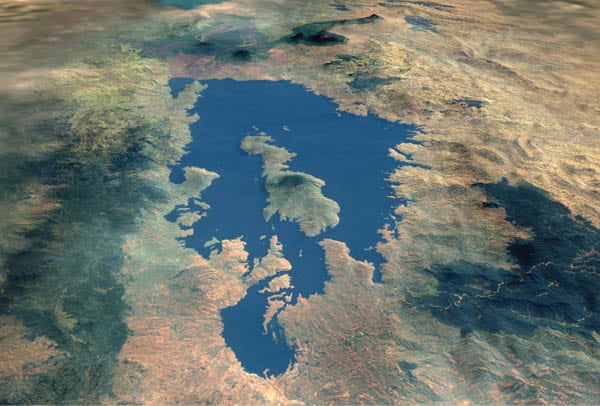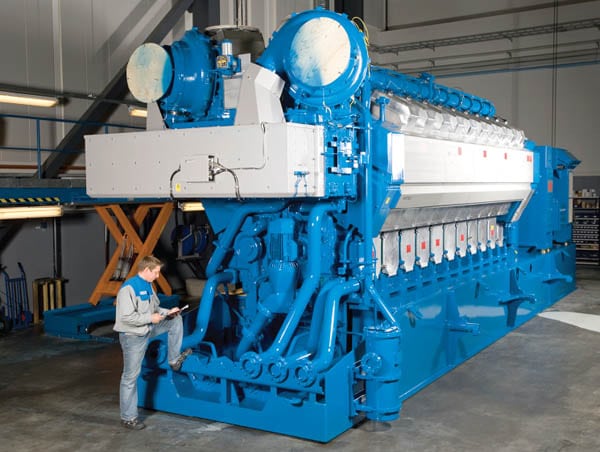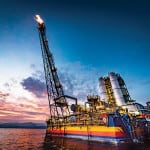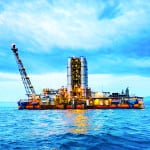Rwanda’s Lake Kivu has a nickname: “Killer Lake.” The shimmering 1,040–square mile body of freshwater on the western branch of the Great East African Rift that straddles the Democratic Republic of Congo and Rwanda (Figure 3) has had a bloody history. Not only was it the site of atrocity during the 1994 Rwandan genocide, but scientists say that it is also one of three known “exploding lakes.”
 |
| 3. Killer lake. The 1,040–square mile Lake Kivu in Rwanda on the expanding Eastern African Rift Valley, adjacent to active Nyiragongo Volcano, contains massive amounts of dissolved carbon dioxide and methane that could prove catastrophic for nearly 2 million people who live in the lake basin if the lake “overturns” and gas suddenly erupts from deep in the lake. In 1986, a carbon dioxide cloud emanating from 1-square-mile Lake Nyos asphyxiated 1,700 people. Source: NASA |
Along with Lakes Nyos and Monoun in Cameroon, Lake Kivu’s lake bed lies over the expanding rift, which contains massive amounts of gases beneath its surface, including 61.4 cubic miles of carbon dioxide from volcanic rock below, and an estimated 15.5 cubic miles of dissolved methane, produced by bacteria on the lake bed.
If a volcanic eruption were to occur, as scientists claim could happen within the next 100 to 200 years, the results could be catastrophic, dwarfing similar events at the two other exploding lakes, because an estimated 2 million people live in the lake basin. In 1986, for example, when Lake Nyos exploded, it released a 1.6 million metric ton cloud of carbon dioxide that asphyxiated an estimated 1,746 people, 3,000 cattle, and countless wild animals, birds, and insects over a 12-mile radius of the 1-square-mile lake. Just two years earlier, in 1984, a loud boom heard from Lake Monoun was caused by a limnic eruption—a rare disaster also known as lake overturn, in which a gas suddenly erupts from deep in the lake—that suffocated 37 people.
Acutely aware of the lethal risks posed by the lake, Rwanda’s government has sought to mitigate the environmental hazards by reaping the estimated 13 cubic miles of methane thought to be dissolved at a depth of 984 feet (the lake is 1,594 feet deep), instead of venting gases, as was done at Lake Nyos in 2001. In 2009, the government signed a $325 million deal with U.S.-based Contour Global for a two-phase plan that will comprise integrated methane gas extraction and production facilities and an associated power plant with capacities reaching 100 MW.
The first $142 million phase of the project, dubbed “KivuWatt,” entails a 750-ton barge that will house a gas extraction facility and a 25-MW power plant comprising three gas engine generator sets. It is expected to be completed in the fall this year. Phase 2 will add another 75 MW of capacity, via another nine gensets and three new barges (one for every 25 MW of capacity). Finnish company Wärtsilä will supply the 20-cylinder 34SG gas-powered engines; delivery of the first 25-MW phase is expected this spring (Figure 4).
 |
| 4. Harnessing lake methane. Wärtsilä’s 20-cylinder 34SG gas-powered engine will power the first 25-MW phase and future 75-MW phase at a plant under construction by U.S. energy firm Contour Global that will burn methane sourced from saturated waters at Rwanda’s Lake Kivu. The $142 million first phase, which will be completed in October this year, has garnered the backing of international banks because it also seeks to avert the threat of an eruption of carbon dioxide and methane at the lake. Courtesy: Wärtsilä |
Wärtsilä, which will also build the plant on a turnkey basis, said it conceived the idea for the plant and proposed it to Contour Global after learning about a much smaller Lake Kivu power project run by beer-maker Heineken. That company pipes water and methane up from the lake, separates the gas, and burns it in a combined heat and power plant dedicated to one of its small breweries. KivuWatt is expected to be the first large-scale attempt to harness power from the lake’s methane.
And there could be much more to come. According to Wärtsilä’s regional director for Africa, Tony van Velzen, the methane trapped at Lake Kivu is growing at a rate that could fuel about 80 MW per year. “This is why the project has been sized at 100 MW. Actually there is enough gas to run the plant indefinitely,” he said. “A future idea is to raise power generating capacity to 300 MW, which will sustainably reduce the pressure of the lake. If it works it will be incredible.”
The project also includes a floating pipeline to transport the fuel gas ashore from each barge and an onshore gas-receiving facility. Power produced by the project will be sold under a 20-year purchase agreement to Rwanda’s national utility, the Energy, Water, and Sanitation Authority (EWSA), which says the electricity is badly needed to drive Rwanda’s burgeoning economy. Only 6% of the population had access to power in 2008, by EWSA’s estimates. However, the electricity could also be exported to neighboring power-stricken countries like Uganda in the future, Contour Global says.
—Sonal Patel is POWER’s senior writer.










